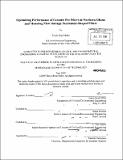Optimizing performance of ceramic pot filters in Northern Ghana and modeling flow through paraboloid-shaped filters/
Author(s)
Miller, Travis Reed
DownloadFull printable version (40.92Mb)
Other Contributors
Massachusetts Institute of Technology. Dept. of Civil and Environmental Engineering.
Advisor
Susan Murcott and E. Eric Adams.
Terms of use
Metadata
Show full item recordAbstract
This work aimed to inform the design of ceramic pot filters to be manufactured by the organization Pure Home Water (PHW) in Northern Ghana, and to model the flow through an innovative paraboloid-shaped ceramic pot filter. PHW is an organization dedicated to improving the drinking water quality for residents of Northern Ghana, where waterborne diseases harm many people. Until 2010, PHW purchased filters manufactured in distant Accra, Ghana for distribution. Recently, the organization decided to establish a factory closer to the point of distribution in Tamale, Ghana. Previous research in other parts of the world had demonstrated that filters could maintain high coliform and turbidity removal performance despite having higher flow rates than typically recommended. 15 types of filters were designed to test the incorporation of grog, type of combustible material, method for processing combustible material, combustible to clay ratio, and shape of the filter. The statistically significant effect of each design variable on E. coli removal, total coliform removal, turbidity removal and flowrate was tested. Results from a related durability study were added to make recommendations for PHW. The recommended filter type incorporates hammer milled, un-sieved, rice husk in a 4:11 proportion to clay by mass. The incorporation of grog and shape of the filter are left up to the factory's discretion, as they have do not have significant impact on performance. Previous research described the flow through flower pot shaped filters as a function of Darcy's Law, and this work continued that effort by describing flow through a paraboloid shaped filter. The geometry of the filter was determined experimentally and modeled. A model was developed based on Darcy's Law and the filter geometry which describes flow through the filter. Additionally, an assumption that the hydraulic conductivity was consistent throughout the height of the filter was tested. Three different methods were used to determine the hydraulic conductivity with height of the filter. The hydraulic conductivity was determined to be consistent throughout its height.
Description
Thesis (M. Eng.)--Massachusetts Institute of Technology, Dept. of Civil and Environmental Engineering, 2010. Cataloged from PDF version of thesis. Includes bibliographical references (p. 136-137).
Date issued
2010Department
Massachusetts Institute of Technology. Department of Civil and Environmental EngineeringPublisher
Massachusetts Institute of Technology
Keywords
Civil and Environmental Engineering.